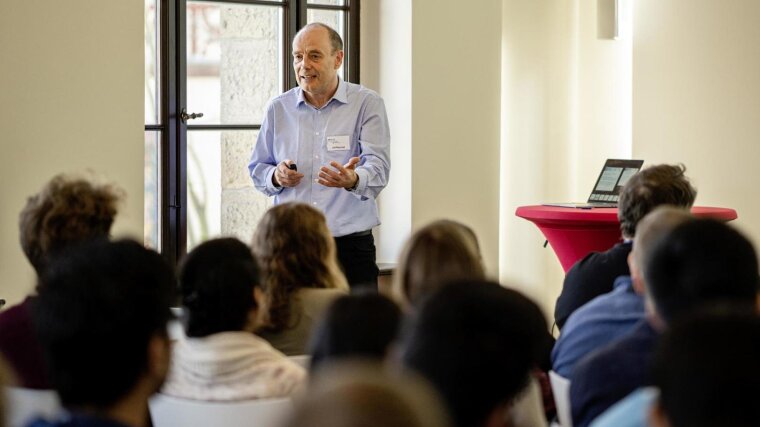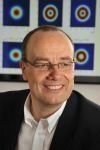
Prof. Dr. Ulf Peschel
Image: PrivateProf. Dr. Ulf PESCHEL
Email: ulf.peschel@uni-jena.de
Phone: +49 3641-9-47170
Ulf Peschel is chairholder at the Institute of Solid State Theory and Optics, a Senior Fellow of the Optical Society of America, a member of the Coucil of the Abbe School of Photonics, and Spokesperson of the cooperative research center SFB 1375 „Nonlinear Optics down to Atomic scales (NOA)“.
Some of Ulf Peschel's current research activities focus on the time evolution of optical pulses in fiber systems. Together with his group "Nonlinear Optics and Nanophotonics (NONA)" and for the first time, he realized a discrete system in the time domain and investigated time discrete temporal solitons. He currently studies optical systems with balanced gain and loss, which may allow for the formation of fractal patterns and if they obey parity-time (PT) symmetry also for sudden phase transitions and unidirectional invisibility. Recently, the group observed the first PT-symmetric optical solitons. Ulf Peschel's research in the field of nanophotonics is concentrated on metamaterials, photonic crystals and plasmonic structures. Together with his co-workers he developed new methods to characterize highly focused beams and explored the optical response of dielectric-plasmonic crystals. For the first time, his group realized the excitation of sub-wavelength plasmonic gap-waveguides and of plasmonic nano-circuitries via nanoantennas. Modelling activities focus on the efficient implementation of codes simulating light-matter interaction in semiconductor nanostructures based on finite-difference time domain (FDTD) codes coupled with semiconductor Maxwell-Bloch equations.
Research Areas
Ulf Peschel has been working in the field of optics for more than 20 years, both theoretically and experiment-ally, with a focus on integrated optics, nanophotonics, nonlinear dynamics and electromagnetic modelling. He theoretically investigates the interaction between light fields and quantum systems on the nanoscale leading to nonlinear optical effects as higher harmonics generation or exciton-polariton condensation in semiconductor nanostructures. He also performs experiments on the field evolution in optical fiber systems, in which discreteness is realized in the temporal domain, and where gain, loss and phase modulation can be tuned to experimentally realize new phenomena as topological protection, parity-time symmetry, entanglement or superfluidity of light.
Teaching Fields
Prof. Peschel is currently giving lectures on the theoretical concepts of modern optics, including the linear and nonlinear aspects of light-matter interaction.
Research Methods
A computer cluster including respective software and licenses is hosted and maintained in Ulf Peschel's group. The group has vast experience in the numerical solution of various optical problems and uses a lot of standard methods of electromagnetic modeling, including the beam propagation method, finite difference time domain (FDTD) codes and eigenmode solvers. A running fiber loop setup is available for proof-of-principle experiments on linear and nonlinear dynamics in optical systems.
Recent Research Results
Some of Prof. Peschel’s current research activities focus on the time evolution of optical pulses in fiber systems. Together with his group, he for the first time realized a discrete system in the time domain and investigated time discrete temporal solitons [1]. He could demonstrate that the dimensionality of a fiber system can be increased by will thus allowing for the demonstration of genuine two-diemnsional effects in originally one-dimensional settings [2]. He currently studies optical systems with balanced gain and loss, which obey parity-time (PT) symmetry, which allow for sudden phase transitions and unidirectional invisibility [3]. The group observed the first PT-symmetric optical solitons in one [4] and two transverse dimensions [5]. Studies on topological effects resulted in the first experimental measurement of the Berry curvature in an optical system [6]. Prof. Peschel is modelling activities focus on the efficient investigation of exciton-polariton dynamics in resonantly excited semiconductor resonators, in particular on condensation and soliton formation in these structures [7] implementation of codes simulating lightmatter interaction in semiconductor nanostructures based on finite-difference time domain (FDTD) codes coupled with semiconductor Maxwell-Bloch equations [8]. Ulf Peschel is currently the speaker of the cooperative research center SFB 1375 „Nonlinear Optics down to Atomic scales (NOA)“. His research activities focus on the modeling of quantum effects stimulated by strong light fields.
[1] Bersch et al., Phys. Rev. Lett. 109, 093903 (2012).
[2] Muniz et al., Scientific Reports 9, 9518 (2019).
[3] Regensburger et al., Nature 488, 167 (2012).
[4] Wimmer et al., Nature Comm. 7782 (2015).
[5] Muniz et al., Phys. Rev. Lett. 123, 253903 (2019)
[6] Wimmer et al., Nature Physics 13, 545 (2017).
[7] Egorov et al., Phys. Status Solidi B 2019, 1800729 (2019).
[8] Buschlinger et al., Phys. Rev. B 91, 045203 (2015).
Link to the Solid State Optics GroupExternal link
Link to the SFB 1375 "NOA - Nonlinear Optics down to Atomic scales"
